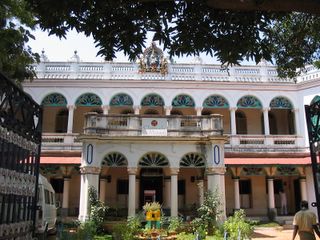There are many places to eat authentic Chettinad food (I am a sucker for food, so I believe what the blurbs on name boards and menu cards say). Some of the more prominent ones are Anjapaar, Ponuswamy and Kaaraikudi. These hotels have a number of branches and hence are well spread out in the city. So if you want to eat a Chettinad meal, It is quite likely that the area in which you are will have a branch of these restaurants nearby. Then to visit a Chettinad house, you could visit DakshinaChitra, an open air museum of South Indian Culture started by an American lady Dr. Deborah Thiagarajan. This centre is now the home many authentic houses from Kerala, TN, AP and Karnataka. They have been dismantled, numbered carefully and reconstructed to the original form. Along with these architectural experiences, one can browse around in the craft shop that showcases handicrafts from these states. On weekends and during festival seasons, one can see how some of these crafts are produced. To pick up exclusive crafts from Chettinad, one can head towards M.Rm.Rm Foundation set up and run by Mrs. Visalakshi Ramaswamy. She has revived many crafts forms and has received International recognition. One can purchase Kottans (lovely woven baskets for which UNESCO has given their seal of recognition for this crafts), Attangudi Tiles (floor tiles made in vivid colours and designs that don the traditional houses) and handwoven sarees both in cotton and in silk with typical Chettinad designs. One can set aside a day to experience at a leisurely pace or can run through these sights and tastes in half a day.
There are many ways in which one can experience Chettinad heritage in Chettinad region and my Chettinad experiences have been in bits and pieces over the years. The source can be traced to Chennai years ago. I was in this city for a cousin’s wedding and I a missed opportunity to eat at a ‘Chettinad’ restaurant. Considering that I like food very much it was quite natural that I felt disappointed and wanted to make amendments the next time I was in the city. I had to wait for about 12 years for that. Due to some chance happening I moved to live in Chennai and after we settled I wanted to fulfil that desire of eating Chettinad food. Naturally as a newbie to the city, I asked acquaintances about which restaurant to go to. In addition to some names of restaurants, I was told that this cuisine is more renowned for its non veg preparations and that I, a vegetarian, will have limited choice. Nonetheless, when an opportunity presented itself, I took a Dutch friend of mine, who appreciates many good things about India including the spicy food, to Kaaraikudi, a restaurant chain that specialises in Chettinad cuisine. During the days that preceded this dinner, when my friend and I ate out, kozhambu (tamarind based chutney) was something both of us liked very much. So we were quite happy to order poondu kozhambu (with large pieces of garlic in it) and kathirikai kozhambu, (with eggplant) along with Chettinad Biryani and Malabar Parata. The waiter recommended crispy valiapoo vadai (banana flower vada) as starters. Frankly, there was not much of a choice for a veggie but then when the food did arrive, we did not speak a single word during the entire meal; it was just appreciative nods all the way. Although I ate this meal over a year ago the fact that I can still recall the menu seem to indicate that I have an elephantine memory but it is not so. Considering that I have gone back to this restaurant few times and considering that there is little to choose for a vegetarian, it is not difficult to jog the memory (and the taste buds too)
Taking into account that we were to take a group of Dutch tourists on a food tour of south India, after the first meal itself, we decided to explore possibilities of including Chettinad in the tour. My friend left for his home that night and it was my responsibility to investigate. After couple of months of casual research, I had some information and few cancelled train tickets. With time not entirely on our side, my friend, who arrived just before the trip started, managed to organise a day long trip for himself from Madurai. Strangely, I was in The Netherlands then. His feedback was that the roads were bad but it would be extremely interesting for the group to spend a day visiting some of the temples and then to have a meal at Bangla, a restored mansion in Karaikudi that now operated as a heritage hotel. The plan was to leave early in the morning from Madurai, go to Pilliarpatti, where the morning aarti is carried out at 9 AM. Then go to Kundrakudi a Murugan temple on a large rock. Subsequently we planned to go to Kannadukattan, the main Nathukottu Chetiar’s village and finally to Bangla for lunch.
Although we started early, we could not get to Pilliarpatti by 9AM, we were little late. We jumped off the bus and rushed straight into the temple, the aarti was just getting over. We saw the last part of the aarti and even that was quite impressive. The plate with burning camphor circling around an impressive 6 ft Karpaga Vinayaka idol, accompanied with live music and temple bells was quite celestial. Since the group could not enter temples in Kerala or the Meenakshi temple in Madurai, this was the first entry into a Temple for some of them, they I am sure would have been more impressed then I was.

Pillayarpatti temple
Although, the priests told us we could take snaps as long as the deity is not in the picture frame but the guards and the security personnel did not allow us to do so. Since I could not speak Tamil, it was not possible to explain that the priests gave their consent. The next best thing to do was to look for the priests but they were nowhere to be seen. We wandered out and then walked around the temple for a little while. I took some surreptitious snaps as I walked out but none of came out right. Meanwhile, the group got even more disbursed - some members were busy buying trinkets from the shops, couple of others were busy taking snaps of the cows, few were walking around the temple zone and some headed back to the bus. It took a little while to gather them and be on the way to Kundrakudi.
Kundrakudi is famous for a Murgan temple situated on a large rock. At the base of the rock is a small temple with lovely paintings all around, including on the roof. To get to the main temple one has to climb a flight of steps carved into the rock. Even though it was the middle of the day, the climb was not difficult, with gentle breeze and sylvan sights to assist you.

Temple steps
On the right side of the rock was the village with its ‘country tile’ roofs and the left side was natural landscape that extended for quite a distance. Amidst the village one could see the large temple chariot towering over the roofs. It was festooned with mango leaves from a recent temple festival. Once in the temple, I sat in a corner to watch the people. The group wandered around smiling and saying hello to the people. Little kids encouraged by the family came up shyly to shake hands with them. Some of the lesser shy ones asked the group for their names, as the rest of their family stayed in the background, beaming with pride. I can tell that it takes a lot of guts to go up to a stranger and ask for their names, that too strangers from distant lands. I don’t think I can still do that, so I thought the families have all the reason to beam and be proud of their kids.
After few more km of bad roads, we finally arrived at Kannadukattu. A winding path from the edge of the village lead up to the main attraction: the raja’s palace. As we drove into the village the sights the villages had to offer were quite surreal: considering that the village was middle of no-where it had some of the most massive mansions I have ever seen. The group must be even more dazed to see them. The palace where the wealthiest of the Chettiars lived was newly painted. I guess, it was more because of the wealth and the land this family controlled, the head of it was called the Raja and his residence has come to be known as ‘the palace’. Later on I came to know that this place gets painted every January. Since we visited in mid-February, the paints were still bright. While the group went in, I walked around the village to take a few photos. Two more bus loads of overseas tourists came in.

The raja's palace

The passage from the entrance to the 'palace'

Athangudi tiled passage

Verandah in Bangla

Waiting area in the Bangla

One of the heritage hotels
I guess Chettinad is finally getting onto the tourist map of the country but unfortunately it is the overseas visitors that seem to throng to this place. The only other people who throng this place are antique hunters who carry the dismembered parts of a Chettiyar house to where ever they can sell at exorbitant prices. Next time I am in the Chettinad region, I will make some time to pick up some good deals so that a part of Chettinad is always close by.

No comments:
Post a Comment